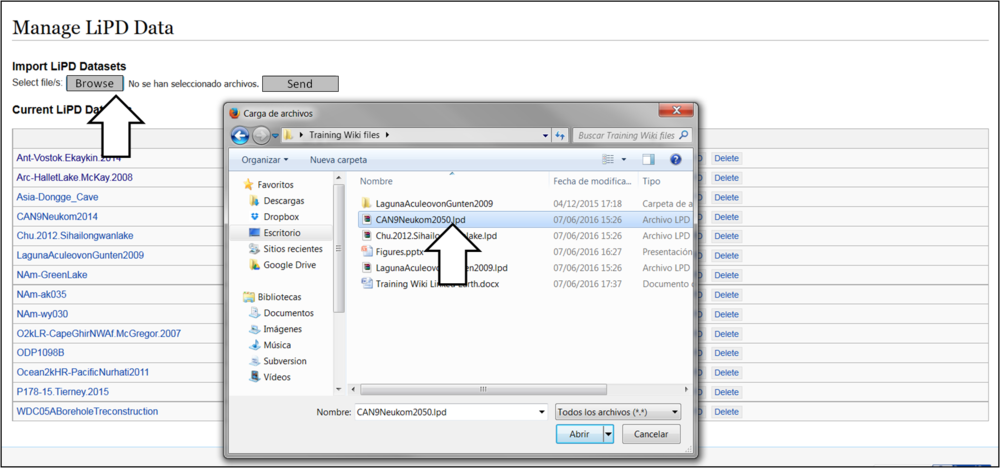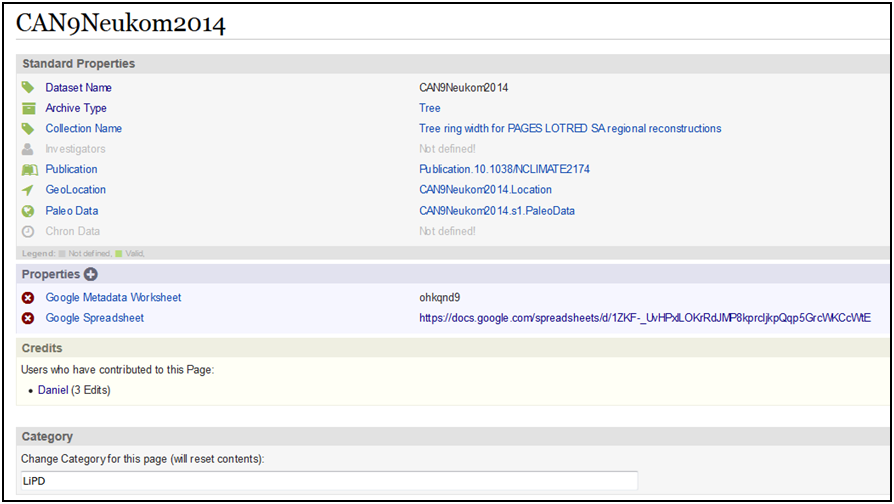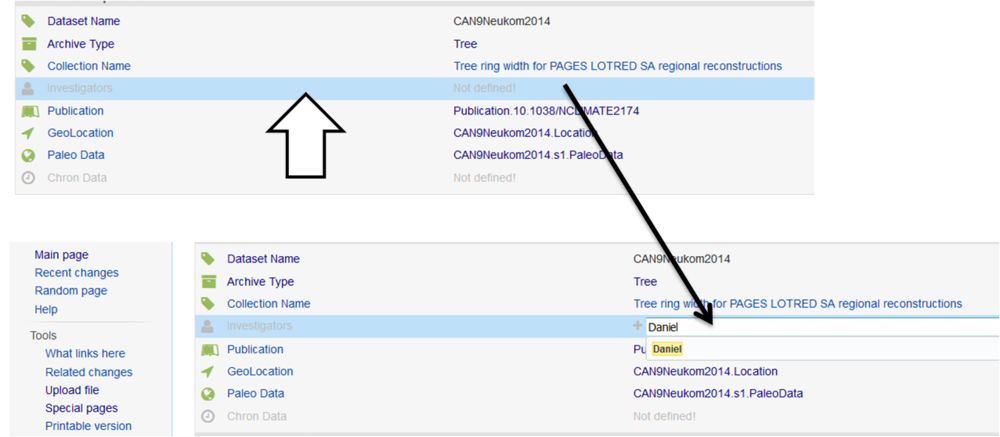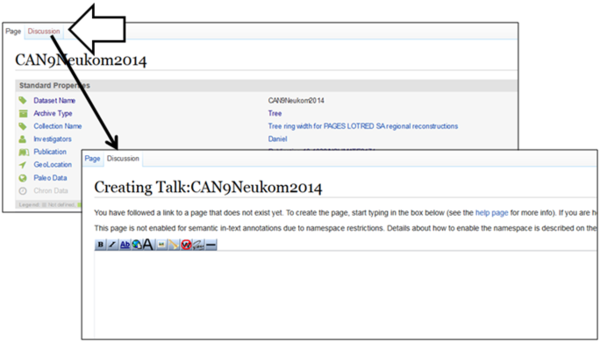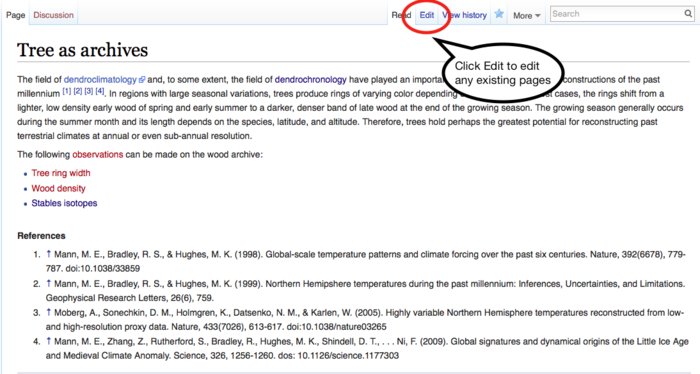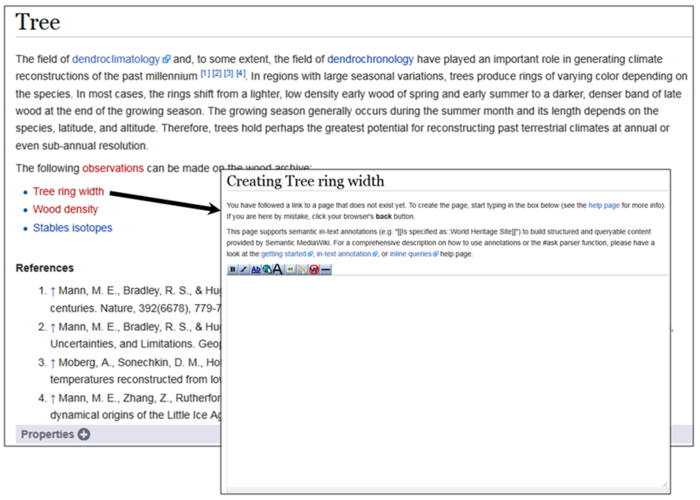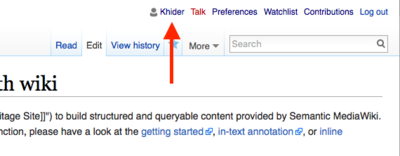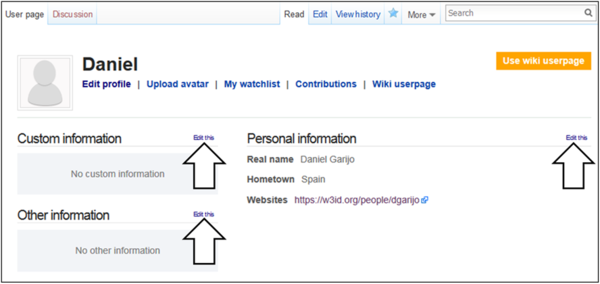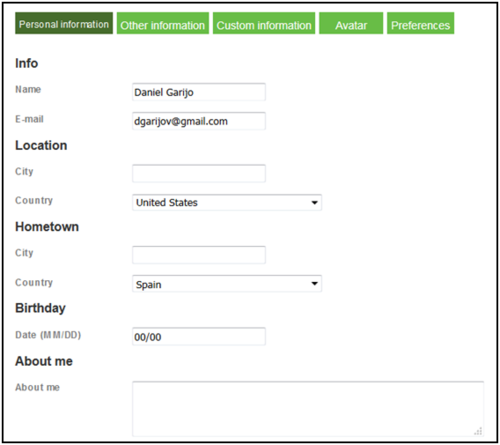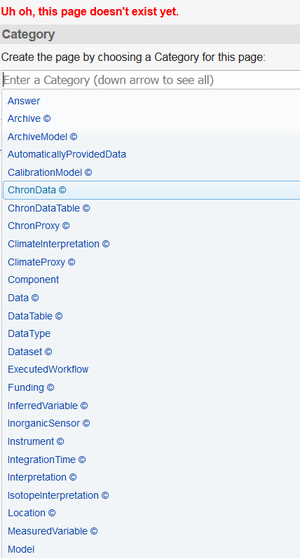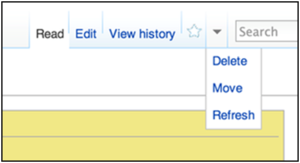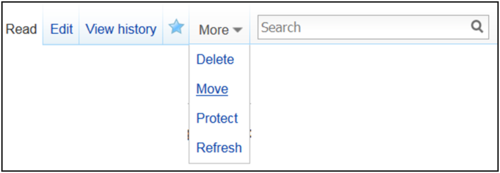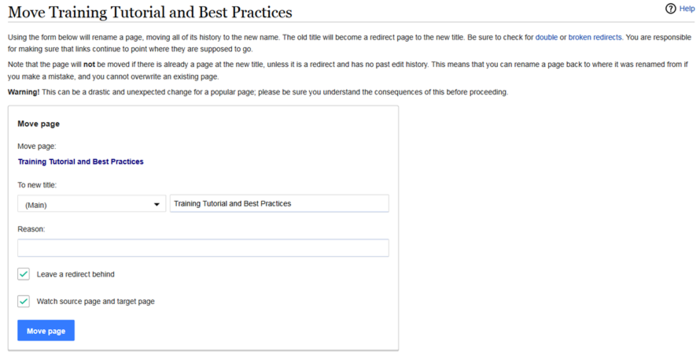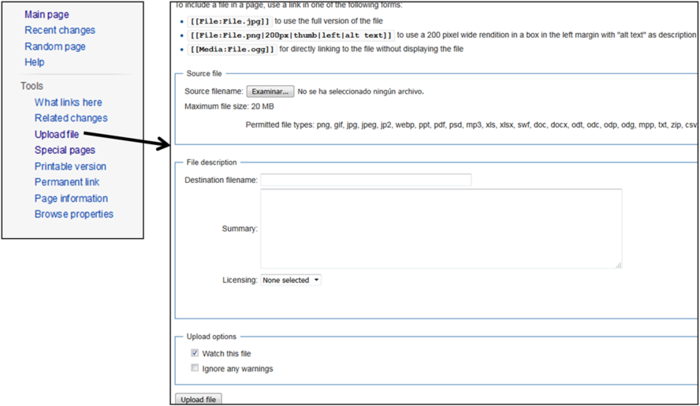Difference between revisions of "Dataset Tutorial"
m (Change the section name for dataset annotation) |
(edit adding a location to the dataset) |
||
| Line 50: | Line 50: | ||
Each property/property value added to the page is tracked on the page history. The page history is accessible through the "View history" button at the top of any wiki page (see Figure 1 for more details). This way, everyone can monitor the edits done by other wiki users. Figure 6 illustrates the edits for the CAN9Neukom 2014 dataset: the latest change added a propertyValue adding "Daniel" as an investigator. | Each property/property value added to the page is tracked on the page history. The page history is accessible through the "View history" button at the top of any wiki page (see Figure 1 for more details). This way, everyone can monitor the edits done by other wiki users. Figure 6 illustrates the edits for the CAN9Neukom 2014 dataset: the latest change added a propertyValue adding "Daniel" as an investigator. | ||
| − | LinkedEarth members who are at the dataset contributors level can only edit the properties associated with the dataset they contributed. Starting at the Basic Editor level, users can edit datasets contributed by other users. If you would like to become a basic editor, please | + | LinkedEarth members who are at the dataset contributors level can only edit the properties associated with the dataset they contributed. Starting at the Basic Editor level, users can edit datasets contributed by other users. If you would like to become a basic editor, please [mailto:linkedearth@gmail.com email the Editorial Board]. |
[[File:TutorialFig6.png|thumb|none|800px|Figure 6: History of the edits done to the CAN9Neukon2014 dataset]] | [[File:TutorialFig6.png|thumb|none|800px|Figure 6: History of the edits done to the CAN9Neukon2014 dataset]] | ||
| Line 96: | Line 96: | ||
== Adding location to a dataset == | == Adding location to a dataset == | ||
| − | + | The LinkedEarth wiki automatically add a new dataset to an existing query page, such as the one on our [[Main Page]], provided that the dataset contains a set of coordinates. To do so, flirt link the location used to collect the data as illustrated on Figure 24. Any location is valid, from a single point (in a xyz coordinate systems) to a polyline (e.g., a river), or even a polygon (e.g., a mountain, a city or even a country). In the example, we are linking the dataset to the location "Central Andes composite 9", where the data was collected. | |
Once the location page has been created, we can annotate its name and its associated geometry with the property "hasGeometry". This property takes into account the fact that a location may change over time (e.g., a river could change its course), and hence the geometry would change without affecting the location itself. | Once the location page has been created, we can annotate its name and its associated geometry with the property "hasGeometry". This property takes into account the fact that a location may change over time (e.g., a river could change its course), and hence the geometry would change without affecting the location itself. | ||
| − | Finally, we add the coordinates to the Geometry (if the page doesn't exist already). For this we use the AsWKT property, which indicates to the system that the coordinates are in | + | Finally, we add the coordinates to the Geometry (if the page doesn't exist already). For this we use the AsWKT property, which indicates to the system that the coordinates are in the [https://en.wikipedia.org/wiki/Well-known_text Well Known Text format]. Since in this case we are representing a point, we also add type "Point" as property for the geometry. |
Revision as of 18:18, 8 August 2016
This tutorial is meant to get you started with uploading and editing a dataset onto the LinkedEarth platform. The LinkedEarth Wiki is based upon semantic iMediaWiki and therefore uses the MediaWiki language. If you are new to Wiki formatting, take a few minutes to learn how to edit pages, create new pages, use links on the Help Page.
After completing this tutorial, you will be able to:
- Getting started with LinkedEarth: Request an account and log into the wiki.
- LiPD and LinkedEarth: Upload LiPD datasets and enter basic metadata for the record.
- Annotate a dataset: Create and reuse properties for annotation.
- Advanced Functionalities: Create and edit wiki pages, special pages, and uploading files.
Contents
Getting started with LinkedEarth
Getting a Linked Earth wiki account
To get an account on the Linked Earth wiki, use the membership form.
Logging in the Wiki
To log in, just click on the link at top right of the wiki and insert your user/password as shown on Figure 1.
LiPD and LinkedEarth
The LinkedEarth Ontology represents the backbone of the wiki. The ontology allows us to not only define terms commonly used to describe a paleoclimate dataset (e.g., variable, uncertainty, calibration) but also specify the relationship among these terms (e.g., a variable has uncertainty). As such, it allows us to make inferences, support complex queries, as well as perform quality control on the data.
The LinkedEarth ontology was developed from the LiPD format championed by Nick McKay and Julien Emile-Geay. Therefore, the wiki platform is currently optimized to accept data already in the LiPD format. There are several ways to convert your dataset to LiPD. Go to the LiPD webpage for more information.
Uploading a LiPD file
You need to be logged in to upload a LiPD file, using a special page dedicated to the management of datasets already in the LiPD format. Select the browse button and choose the .lpd file you want to upload as shown in Figure 2:
Dataset pages will be automatically created from the content of the LiPD file and your dataset will appear at the top of the "Current LiPD Dataset list" on the Main Page. By clicking on the dataset link, you will be able to see the automatically extracted data and metadata from the LiPD file, as shown in Figure 3. New "crowd" properties will be automatically created from the LiPD file if these properties are not in the current core ontology.
Congratulations! Your LiPD file has been successfully added to the Linked Earth wiki.
Exercise: upload your own LiPD file through the "manage dataset" page in the wiki.
Annotating a LiPD file
Once a LiPD file is uploaded, the metadata about that file is shown in a table with two columns. The column on the left of each table contains the properties describing the LiPD file, while the column on the right states the value associated with each property. Figure 3 shows an example, where the "archive type" of CAN9Neukom2014 is "Tree".
Please check that the metadata for your record is correct and edit it if appropriate. For instance, to add an investigator to the CAN9Neukom2014 dataset in Figure 3, click on its corresponding row as indicated in Figure 4. Then type the value of the property. In this example, we added "Daniel" as the investigator.
All annotated values can be edited or removed. To remove "Daniel" from the investigators of the example dataset, click on the row and on the red cross button of the left as shown in Figure 5:
Each property/property value added to the page is tracked on the page history. The page history is accessible through the "View history" button at the top of any wiki page (see Figure 1 for more details). This way, everyone can monitor the edits done by other wiki users. Figure 6 illustrates the edits for the CAN9Neukom 2014 dataset: the latest change added a propertyValue adding "Daniel" as an investigator.
LinkedEarth members who are at the dataset contributors level can only edit the properties associated with the dataset they contributed. Starting at the Basic Editor level, users can edit datasets contributed by other users. If you would like to become a basic editor, please email the Editorial Board.
If there is a disagreement between two researchers, a discussion may be started on the "Discussion" page, as depicted on Figure 7. Contributors and Editors may edit any Discussion Pages on the wiki. To learn more about how to contribute and edit discussion pages, follow this Discussion Page Tutorial.
Contributions is tracked automatically on the wiki and displayed in the "Credit" section, which can be found at the bottom of each wiki page.
Dataset versioning
In LiPD all the uploaded datasets should follow a x.y.z notation, where "x" refers to important changes in the dataset's metadata (e.g., the creation of a new age model using a different code), "y" refers to changes to the data following a publication (e.g., adding data further back in time without changing the model underlying the interpretation) and z refers to minor changes not associated with a publication (e.g., typos). For example, the first official release of a dataset would be 1.0.0. If I fix a small typo, I would create version 1.0.1.
Exercise: Annotate the version of the dataset in the recently created page, following the x.y.z notation and using the property "datasetVersion".
Concept annotation in a LiPD file
As shown in Figure 4 and Figure 5, some of the annotated values like "Tree" already have links to other pages. These pages can be further populated and edited by domain experts. To do so click on the Edit tab at the top of the page as shown on Figure 9 for the "Tree" archive. The article was created as a stub, awaiting domain experts' contribution, further gathering field knowledge.
To learn more about Wiki editing, visit the MediaWiki Help.
By linking to other existing pages we can connect different LiPD datasets (e.g., if two different datasets are of the same archive type, they will link to the same page) and support queries. For instance, one can look for all the datasets on the LinkedEarth wiki using "Tree" as archives.
Red links means that the page does not yet exist. Editors and contributors can create the new page and edit its content. An example can be seen on Figure 10.
Exercise: edit the page "Tree ring width", which does not have a definition at the moment, and add a test definition. Use this link as the "Archive Type" value on your uploaded LiPD dataset .
Annotate a dataset
Property annotation
Until now we have covered how to annotate property values and associate them to concepts and existing pages in the wiki. In this next step we will see how to create new properties to describe a dataset, i.e., adding new annotations to our dataset outside of the standard properties shown in Figure 3.
The "Properties" box, placed under the "Standard Properties" table, allows users to edit and create new properties and values. An example is shown in Figure 11. By clicking on the "plus" sign in the title, a new row will appear on the table. The row has two fields, one for adding the property name we want to use to describe the dataset (e.g., title, description, name, etc.) and another row for inserting the property value.
Before adding a new property name, it is important to note that a similar property may already exist in the ontology to describe the same metadata. The properties are case-sensitive. For instance, imagine that we want to add a "description" to the dataset. If we start typing the property, we see that it already exists, and we can select it for our purposes. Selecting existing properties is important, as it helps to structure and control the content uploaded to the wiki.
Exercise: create a "title" property and use it to annotate your uploaded dataset. Check if the property already exists. If it doesn't, create it.
Adding location to a dataset
The LinkedEarth wiki automatically add a new dataset to an existing query page, such as the one on our Main Page, provided that the dataset contains a set of coordinates. To do so, flirt link the location used to collect the data as illustrated on Figure 24. Any location is valid, from a single point (in a xyz coordinate systems) to a polyline (e.g., a river), or even a polygon (e.g., a mountain, a city or even a country). In the example, we are linking the dataset to the location "Central Andes composite 9", where the data was collected.
Once the location page has been created, we can annotate its name and its associated geometry with the property "hasGeometry". This property takes into account the fact that a location may change over time (e.g., a river could change its course), and hence the geometry would change without affecting the location itself.
Finally, we add the coordinates to the Geometry (if the page doesn't exist already). For this we use the AsWKT property, which indicates to the system that the coordinates are in the Well Known Text format. Since in this case we are representing a point, we also add type "Point" as property for the geometry.
Adding and extending concepts (e.g., how do I refer to the instrument used in my lab?)
Sometimes one may want to extend some of the concepts that already exist in the wiki. For example, imagine that I have measured a variable of a table (d18Og.rub-w) with the stable isotope ratio mass spectrometer instrument housed in my lab. If I state that the variable d18Og.rub-w was measured by a "stable isotope mass spectrometer instrument" (under the "instrument" category) I would be losing information: are all stable isotope mass spectrometer instruments the same?
We need to state which stable isotope mass spectrometer was used. In this case, the one in my lab.
Hence, we need to create the concept "StableIsotopeRatioMassSpectrometerInMyLab", referring to a specific "Instrument" with its own property values. For instance, two instruments from the same brand/model could have different reported uncertainty. Following the example shown in the previous section, we would need to create the "StableIsotopeRatioMassSpectrometerIfMyLab" page and annotate it with the category "StableIsotopeRatioMassSpectrometer". This category would become a new category in the wiki, referring to stable isotope ratio mass spectrometer in the more general sense.
Exercise: Use an instrument of your lab to describe a variable from a dataset. If the category of your instrument does not exist, create a new instrument category (e.g., stable isotope mass spectrometer).
Advanced wiki functionality
Creating a personal page
The Linked Earth wiki allows to create different types of pages. Personal pages are a special type of wiki pages, and we will use them to illustrate how to create a new wiki page in general. After logging in on the wiki, click on your name. You can find it on the top of any wiki page, as shown in Figure 12:
Clicking your name will take you to a new page, which you can complete with your personal information, by clicking on any of the "edit options" in the page, as depicted in Figure 13:
And adding your personal information on the form (Figure 14):
After you are done, just hit the "Update" button at the bottom of the page (Figure 15):
Exercise: Create your personal page and add a personal website and an "about me" description.
Creating a new wiki page
Just go to http://wiki.linked.earth/New_Page
Replace "New Page" above to the name that you want for the page.
Then, either select a category for this page (Figure 16):
or, just click on the "Create" link to create a page without any category (Figure 17)
Alternatively, you can search for the page you are looking for (remember that the wiki is case sensitive). If the page does not exist, you will be prompted to create it.
Deleting an existing wiki page
Go to http://wiki.linked.Earth/Name_of_Page Replace "Name of Page" above to the name of the page to delete, as shown in Figure 18.
Then click on the "Delete" link, and delete the page. Figure 19 shows an example:
Searching existing wiki pages
Before creating any page, it is recommended to search if they exist. Searching a page can be done by entering the terms on the search bar located on the top right of any page (see Figure 20).
Any page containing the word introduced in the search bar will be returned.
Renaming wiki pages
Wiki pages may need to be renamed. For example, due to typos in the page name or community agreement. In order to rename an existing page without losing any of its contents, you should click on the "Move" button under the "More" menu on the top of the page. An example is shown in Figure 21.
By clicking on the Move button, the page showed in Figure Figure 22 will ask for the new page name, as well as a reason of the change.
After hitting the "Move page" button, your page will be renamed.
Uploading images and files
If you want to add an image or document to your a wiki page (Not a LiPD file, use the special page described in this tutorial to upload your LiPD file), click on the "upload files" button that can be seen on the left of any wiki page (see Figure 23).
After you are done selecting the document you want to upload, just hit the "Upload file" button at the bottom of the page. Now you may reference to this file using brackets (e.g., [ [ File:File.png ] ]). You can see the different options for showing files in this page: https://www.mediawiki.org/wiki/Help:Images
Best practices
This section will cover naming convntions for instances, publications or versions in a dataset. This is currently under discussion.
TBD

